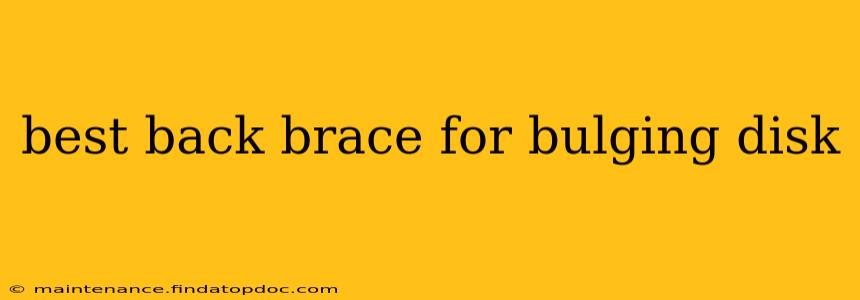A bulging disc can cause debilitating pain and discomfort, significantly impacting your daily life. Finding the right back brace can provide crucial support, alleviate pressure on the affected area, and help you manage your symptoms. However, with a vast array of options available, choosing the best back brace for a bulging disc can feel overwhelming. This comprehensive guide will help you navigate the choices and find the perfect support for your specific needs.
Before we dive into specific brace types, it's crucial to consult your doctor or physical therapist. They can diagnose your condition accurately, rule out other potential causes of your back pain, and recommend the most appropriate treatment plan, which may or may not include a back brace. Self-treating can be risky, so professional guidance is essential.
What Type of Back Brace is Best for a Bulging Disc?
There isn't one "best" back brace for everyone with a bulging disc. The ideal choice depends on several factors, including:
- Location of the bulging disc: The location of the bulge (lumbar, thoracic, cervical) will influence the type of brace needed.
- Severity of the pain and symptoms: Mild discomfort might only require a less rigid brace, while severe pain may necessitate a more supportive option.
- Individual body type and size: A properly fitting brace is crucial for effectiveness and comfort.
- Activity level: Your daily activities will influence the level of support required.
Generally, the following types of back braces are commonly recommended for bulging disc pain:
Lumbar Support Belts/Corsets:
These are often the first line of defense for lumbar bulging discs. They provide gentle compression and support to the lower back, helping to stabilize the spine and reduce strain. They are typically less restrictive than other braces, allowing for greater mobility.
Rigid Back Braces:
These offer more significant support and immobilization than lumbar supports. They are often recommended for more severe cases of bulging disc pain, particularly when significant instability is present. They may be useful after surgery or during periods of intense pain.
Posture Correctors:
While not specifically designed for bulging discs, posture correctors can be beneficial in improving posture and reducing strain on the back. By promoting proper spinal alignment, they can indirectly help alleviate some pain associated with a bulging disc. However, they are generally not enough on their own for significant disc issues.
What are the Different Types of Materials Used in Back Braces?
Back braces are made from various materials, each with its own advantages and disadvantages:
- Neoprene: Offers good compression and warmth, helping to improve blood flow and reduce muscle spasms.
- Cotton: Breathable and comfortable but may offer less support.
- Polyester: Durable and lightweight, often blended with other materials for improved performance.
- Nylon: Strong and flexible, often used in combination with other materials for added support.
How Do I Choose the Right Size Back Brace?
Proper sizing is essential for the effectiveness and comfort of a back brace. Consult the manufacturer's sizing chart carefully. Most braces are sized based on waist circumference or body height. Ensure the brace fits snugly but not so tightly that it restricts blood flow or causes discomfort.
Will a Back Brace Cure My Bulging Disc?
No. A back brace is not a cure for a bulging disc. It's a supportive tool to help manage pain and improve stability. The primary treatments for a bulging disc often involve conservative approaches like physical therapy, medication, and lifestyle modifications. Surgery is rarely necessary unless conservative treatments fail.
How Long Should I Wear a Back Brace for a Bulging Disc?
The duration of back brace usage varies depending on the severity of your condition and your doctor's recommendations. It might be recommended for a few weeks or even longer. It's crucial to follow your doctor's advice and gradually wean yourself off the brace as your pain subsides and your strength improves.
What are Some Exercises I Can Do to Help My Bulging Disc?
Consult your physical therapist for exercises specifically tailored to your condition. Generally, exercises focusing on core strength, flexibility, and posture are beneficial. Avoid exercises that aggravate your pain.
Are There Any Side Effects to Wearing a Back Brace?
While back braces offer numerous benefits, potential side effects include skin irritation, muscle weakness (from overuse), and reduced mobility if worn excessively. Always follow your doctor's instructions on proper usage.
Choosing the best back brace for a bulging disc involves careful consideration of your individual needs and medical advice. Remember, a brace is a supportive tool within a broader treatment plan. Prioritize proper diagnosis, conservative treatments, and professional guidance for optimal management of your condition.
